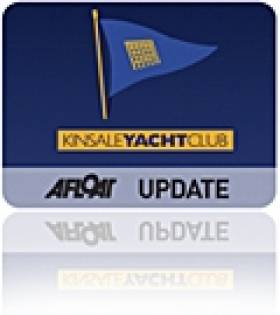Displaying items by tag: Ken Lawless
Quarter Tonners Heading for Sovereigns Cup and ICRA Champs
Up to 25 Quarter Tonners have signed up for Cork harbour's Irish Cruiser (ICRA) National Championships and the Sovereigns Cup in Kinsale – only a week separates the two fixtures. (Latest Sovereigns Cup news here)
The budget-minded class has been back building numbers steadily since 2001 when Peter Morton revived the class on the south coast of England. Now over 40 boats compete in Britain and up to 10 will visit Cork this summer after a successful trial here two years ago.
From June 17th they'll go head to head with a number of hot Irish campaigns that have emerged in the last 12 months, including the host port's "Tiger" (O'Brien, Kenefick and Kenefick), Eamon Rohan's recently refurbished Anchor Challenge and Dún Laoghaire's Supernova, skippered by Ken Lawless.

The crew of Anchor Challenge Complete a gybe. Photo: Bob Bateman
For this year's event, some of these dated 24-26 footers are being pulled from hedgerows and fields rather than building new ones.
Last raced in the 1980s, others are getting the full make-over and have been extensively remodelled for today's IRC handicap rule.
"Budget sailing with five friends, that's the ethos", claims Kinsale skipper Ian Travers about the style of the passe class.
The current fleet contains boats from €6,000 to €30,000, the more expensive boats having extensive optimisation and new sail plans.
It's well within the rules to alter rudders and keels but hull shapes must stay original.
To qualify to race in the Quarter Ton cup, a boat must fall within the old IOR rule or be a production boat derivative. This means many mainstream class-three craft such as Farr 727s, GK24s, Starflash 26s and Boleros all qualify.
Travers reckons therefore a potential Irish fleet could reach 50 boats, if enough owners showed interest.
One boat of particular interest in June will be "Black Fun" a fully refurbished and IRC optimised 1977 Laurie Davidson- designed Quarter Tonner.
Back then she was the top Quarter Tonner in New Zealand but for financial reasons did not make the journey to Finland to compete in the Quarter Ton Cup that year. Now, 34 years later, the current owners are shipping her from New Zealand to compete in this year's cup in Cowes in July but beforehand will compete in both Irish regattas as warm-ups.
And in further good news for the ICRA event a west coast cruiser fleet have confirmed that at least 15 boats will be entering the national championships.
Tiger and Super Nova to Contest UK Quarter Ton Cup
Two boats are travelling from Ireland to take part in the UK's Coutts Quarter Ton Cup hosted by the Royal Corinthian Yacht Club, Cowes, from Monday 14 to Wednesday 16 June 2010. The event is expected to attract a record entry along with some exciting new members of the fleet. Boats will be based in Cowes Yacht Haven for the event, writes Fiona Brown.
Having got a first taste of the fleet aboard his father Neil's Manzanita last year, young George Kenefick will be back again sailing the Kenefick family's newly purchased ASAP know known as TIGER.
This stunning all black 1989 Fauroux design has achieved some great results on the UK circuit for the past two seasons and with the very talented George at the helm plus a crew that includes some of Corks finest young sailors including George Kingston, a Laser European champion, and Donagh Good a Laser Junior National Champion,we can certainly look forward to a good performance from this team.
Tiger has just returned from the Liebherr Cruiser Nationals in Dublin and succesfully won Class 3.
They have begun training for the event and if you look out on Cork harbour this week you will be able to see this immacuately re-stored Quarter tonner.
Also making the trip across the Irish Sea, this time from Dublin, will be Ken Lawless who purchased the immaculately restored Super Nova from Ollie Ophaus and who is looking forward to his first Quarter Ton Cup and just recently finished in third overall in the Liebherr Cruiser Nationals.
For the fifth year running the organisers are delighted to be partnering with Coutts & Co, the UK private banking arm of the Royal Bank of Scotland.
For further information, Notice of Race and Entry Form for the 2010 Coutts Quarter Ton Cup please visit: www.rcyc.co.uk
Keep up to date with Tigers progress on facebook.

























































